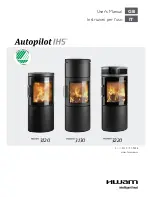
|11
EN
10
4. INSTALLING THE STOVE
General information
Note
Assembly may only be performed by authorised specialist
companies.
Note
Please observe the regional safety and building regulations. Please
contact your master chimney sweep in this context.
Note
Only use heat-resistant sealing materials as well as corresponding
sealing strips, heat-resistant silicon and rock wool.
Note
Also take care that the flue does not project into the free cross-
section of the chimney.
Note
In case of room-air independent operation the stove pipe
connections must be tightly sealed permanently. Use a heat-proof
silicon to position the stove pipe on the conical supports of the flue
tube nozzles and for insertion in the chimney flue lining.
Note
The stove should not be pushed on unprotected floors.
Tip
Strong corrugated cardboard, cardboard or e.g. old carpet is useful
to assist assembly and as a base. The stove can also be pushed on
this cardboard or carpet.
We recommend original flue pipes from RIKA for proper connection.
Connection to the chimney
Q
The
device
must
be
connected
to
an
approved
chimney
for
solid
fuels.
The
chimney
must
have
a diameter of min. 100mm for pellet stoves and
130mm -150mm for log wood stoves depending on the diameter
of the flue pipes.
Q
Avoid long flue pipes to the chimney. The horizontal length of the
flue pipe should not exceed 1.5 m.
Q
Avoid to many bends of the flue gas pipes. There should not be
more than 3 bends in the exhaust pipe.
Q
If you just can not connect directly to the chimney, please use a
connection with a cleaning opening.
Q
Connections must be made of metal and must meet the
requirements of the standard (install the connections airtight).
Q
Before installing a chimney calculation must be made. The
evidence must be performed for single occupancy to EN13384-1
and EN13384-2 for multiple occupancy.
Q
The maximum draft of the chimney should not exceed 15Pa.
Q
The derivation of the flue gases must be guaranteed even during
a temporary power outage.
Note
If connecting to multiple connection chimneys additional safety
equipment is required. Your local chimney sweep will advise you
in this case.
Connecting to a steel chimney
The connection must be calculated and shown with EN13384-1
and EN13384-2.
Use only insulated (double) stainless steel tubes (flexible aluminum
or steel tubes are not permitted).
An inspection door for regular inspection and cleaning must be
present.
The flue pipe connection to the chimney has to be air-tight.
Combustion air
Every combustion process requires oxygen from the surrounding air.
This so-called combustion air is removed from the living are in the
case of individual stoves without external air connections.
This air removed must be replaced in the living space. Very tightly
sealed windows and doors in modern flats may mean that too little
air replaces that used. The situation also becomes problematical due
to additional venting in flats (e.g. in the kitchen or WC). If you cannot
feed in external combustion air, then air the room several times a
day to prevent negativce pressure in the room or poor combustion.
Feeding in external combustion air
only for devices which are able to run in room-air independent
operation.
Q
Combustion air must be fed to the stove from outside via a sealed
pipe for operation independent of the room air. According to
EnEV, it must be possible to shut off the combustion air pipe. The
open/closed setting must be clearly recognisable.
Q
Connect at the air intake either a pipe Ø125mm (log wood and
combi stoves) or Ø50mm (pellet stoves) and fix it with a hose
clamp (not included!). At pellet stoves with longer intake pipes
than 1m the diameter should be increased to 100mm. (see RIKA
range).
Q
To ensure sufficient air intake, the intake pipe should not exceed
max. 4m and have max. 3 bends.
Q
If the line leads outside it must have a windbreak.
Q
In extreme cold pay attention to icing on the air intake opening
(check).
Q
It is also possible to suction in combustion air directly from
another sufficiently vented room (e.g. cellar).
Q
The combustion air pipe must be tightly connected (adhesive or
cement) permanently to the air nozzles of the stove.
Q
If you do not use the stove for a long time, please close the
combustion air intake to prevent the stove from moisture.
Note
Please note that problems may arise due to updrafts in the case
of combustion air supply from an integrated chimney ventilation
shaft. If the combustion air flowing downwards is heated it may
rise and thus counter the chimney with a resistance which in turn
reduces the negative pressure in the combustion chamber. The
chimney manufacturer is to guarantee that the resistance for the
combustion air is a maximum 2 Pa even in the least favourable
operating state of the chimney.
If one or more of these conditions does NOT apply, the result is poor
combustion in the stove and negative pressure in the installation
room.
Summary of Contents for BACK
Page 1: ...Operating manual BACK...
Page 18: ......






































